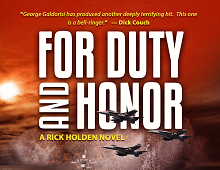Grisham’s Rules

We all have our favorite writers. As a guy who writes primary military techno-thrillers, I tend to gravitate to writers who excel in that genre: Clancy and his successor writers, Stephen Coonts, Dick Couch, Larry Bond, David Poyer, Rick Campbell, P.T. Deutermann and a few others.
But for all of us, there are writers who, while they write in a different genre, are so successful that we hold them up as examples regarding how we should write. John Grisham is one of those writers, and when he is generous with his advice, as he was in his New York Times piece, “John Grisham’s Do’s and Don’ts for Writing Popular Fiction,” We all listen.
Here’s just a taste to whet your appetite:
- DO — WRITE A PAGE EVERY DAY
That’s about 200 words, or 1,000 words a week. Do that for two years and you’ll have a novel that’s long enough.
Nothing will happen until you are producing at least one page per day.
- DON’T — WRITE THE FIRST SCENE UNTIL YOU KNOW THE LAST
This necessitates the use of a dreaded device commonly called an outline. Virtually all writers hate that word. I have yet to meet one
who admits to using an outline.







